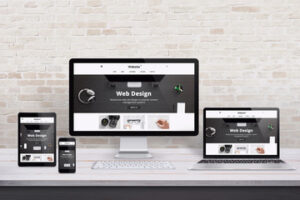The Importance of a Good Web Design Build
The appearance of a website has an enormous impact on its visitors. Consider how a beautiful design led Medium to raise $600 million in venture capital despite being only a writing platform.
Web designers are concerned with the aesthetics of a website, including its layout and color scheme. But they also ensure the site is easy to navigate and feels intrinsic to its brand.
Like a blueprint before the construction of a house, web design wireframes are an essential part of any project. They allow stakeholders and the design team to understand the layout of the site before final decisions are made, avoiding costly changes later in the process.
It’s also an opportunity for everyone to brainstorm ideas and throw in their own thoughts before committing to anything. This can help ensure that the final design will meet all expectations, as well as address any issues that may have been overlooked earlier in the process.
Wireframes are black and white sketches or lines, either hand-drawn or computer generated, which outline the structure of a webpage with dummy content. They don’t need to include colour or graphical images as these are only used to make the wireframe look more attractive. The best tools for creating low-fidelity wireframes are Balsamiq and Axure. Both have a simple and manageable learning curve and are easy to use.
A wireframe allows different parties to focus on the core functionality of a page without the distractions of colours and images. It will also be easier to create a flow for users, ensuring that they can get from one page to another easily and efficiently. This will make the website or app easy to navigate, which is a key factor in the success of any digital product.
Another benefit of wireframing is that it’s a great way to test the usability of your design. With a wireframe, you can see how users will interact with your website or app, and can easily make changes to the interface to improve the user experience. This will save a lot of time and money in the long run, as it will reduce the need for expensive, high-fidelity prototypes.
Another advantage of using wireframes is that it’s a great way for stakeholders and clients to give feedback on the design. Often, it’s difficult for people to voice their concerns when they are working with a full-blown design. This is because they fear that making changes will cost them thousands of dollars and could extend the timeline to complete the project. However, with wireframes, it’s much more cost-effective and quick to make changes – which can be done at any stage of the design process.
Responsive Design
The goal of responsive web design is to create a website that looks good on all devices. This requires a flexible layout, which can be achieved by using fluid grids, resizable images, and CSS media queries. Media queries define a series of breakpoints for different screen sizes. These breakpoints determine when a site’s layout should change, such as when to adjust the column width or hide and reveal content.
To make sure that a site is responsive, it should be tested on various devices and screen resolutions. It’s also important to test a site on mobile networks and in real-world settings. For example, a website should be tested in the subway or at an airport where users may have slower internet speeds than in a conference room or home.
A well-designed responsive website delights online shoppers and encourages them to recommend your business. It also helps your business stand out from competitors, and it can increase the likelihood of potential customers converting into buyers. Responsive websites are essential for modern businesses, as more than half of web traffic comes from mobile devices.
One of the best ways to achieve a responsive design is to use modular pieces that can be resized and shuffled around a page. For example, many designers use em units to set font sizes instead of pixels. These units are based on proportional measurements, so they will appear the same across all browsers and devices. This makes it easy for engineers to pick up and code a design.
Another way to streamline the responsive design process is to use a visual prototyping tool like UXPin, which offers an auto-layout feature that uses flexbox principles. This can save time because it is faster than coding responsive HTML and CSS manually. It’s also helpful for collaboration, since design handoff tools like Zeplin, Sympli, and Marvel can be used to share designs with developers.
While it’s possible to build a website from scratch, doing so can be lengthy and confusing for newcomers to web development. It’s often better to choose a CMS or site builder that supports responsive design. These tools can save you time and effort, and they’ll often come with support teams to help you get started.
Mobile-Friendly
Imagine browsing the Internet on your smartphone and getting frustrated by a website that doesn’t have mobile responsiveness. If your school’s site isn’t mobile-friendly, it’s going to be difficult for students and parents to engage with the information you have available. This type of experience will leave a bad impression on prospective families and could potentially have long-term negative consequences for your school’s reputation.
In an ever-evolving digital landscape, mobile-friendly websites are a necessity for schools to be successful. In fact, mobile devices have now overtaken desktop computers as the primary way that people access the Internet. Having a mobile-friendly website is not only important for SEO, but it is also a must-have for engaging your school’s students, attracting new families, and communicating with existing ones.
The key to creating a mobile-friendly website is to keep it simple and user-friendly. Mobile users are typically looking for specific types of information and have short attention spans. Incorporating a search feature and simplifying the navigation can help to ensure that your school’s website is easy for users to navigate and find what they need. Additionally, resizing images and minimizing plugins can improve page load times and help users with limited data plans to avoid overusing their allowance.
Mobile-friendly websites should also prioritize content prioritization. Due to screen size limitations, it is important for sites to prioritize their most critical information and functionality. This includes making calls-to-action more prominent, ensuring text is readable without zooming in, and that clickable items are large enough to be easily clicked. Finally, when implementing a mobile-friendly website design, it is important to consider how the layout will look on foldable phones and other emerging technologies.
While some schools may be tempted to ignore the importance of mobile-friendly web design, it’s essential that they invest in creating a mobile-friendly site if they want to remain competitive in the modern digital landscape. A poorly designed mobile website will not only be frustrating for users, but it will also hurt their brand image and negatively impact organic search engine rankings. By investing in a mobile-friendly website, schools can reach a wider audience and provide a better customer experience.
SEO
SEO, or search engine optimization, is the process of adjusting your website to improve its visibility on search engines. When done correctly, SEO can increase your website traffic and lead generation, making it a crucial aspect of any web design build.
Incorporating SEO into your design process ensures that the website you’re building will be mobile-friendly, fast, and optimized for organic ranking factors like page speed and image size. Taking the time to incorporate these elements into your site can significantly increase your chances of ranking highly on organic search results pages (SERPs).
When it comes to SEO, it’s all about creating high-quality content that engages visitors and provides them with useful information. This can be achieved by using relevant keywords in your content, ensuring that your website is structured in a way that allows for clear navigation and incorporating text and images that are meaningful to your target audience. It’s also important to keep in mind that Google’s algorithms are constantly changing, so it’s always best to start with a strong foundation that’s easy to update as needed.
As you begin the web design process, be sure to communicate clearly with your web designer about your objectives and goals. This will help them develop a custom web design that will meet your needs. It’s also a good idea to do some research into your competitors’ websites to see what features they have that you may want to include in your own.
The final step of a thoughtful web design process is to test your live site. Using tools such as the Google Mobile-Friendly Test, you can check for any issues that may affect your website’s performance on mobile devices. Make any necessary adjustments and then run a split-test to see if your changes are effective. With these tips, you’ll be able to create a beautiful and functional website that will serve your business well. If you’re ready to get started, contact us today and we’ll be happy to discuss your project! We have years of experience with responsive web design and can’t wait to work with you!






